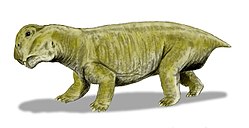| Daptocephalus Temporal range: | |
|---|---|
 | |
| Articulated D. leoniceps skeleton (USNM 23354), National Museum of Natural History | |
| Scientific classification | |
| Kingdom: | Animalia |
| Phylum: | Chordata |
| Clade: | Synapsida |
| Clade: | Therapsida |
| Clade: | † Anomodontia |
| Clade: | † Dicynodontia |
| Infraorder: | † Dicynodontoidea |
| Genus: | † Daptocephalus van Hoepen, 1934 |
| Type species | |
| †Daptocephalus leoniceps Owen, 1876 | |
| Species | |
| |
| Synonyms | |
List
| |


Daptocephalus is an extinct genus of dicynodont synapsid, which was found in Late Permian strata, in a biozone known precisely for the presence of fossils of this dicynodont, the Daptocephalus Assemblage Zone, in the Karoo Basin in South Africa. [2] [3] An additional species, D. huenei, is known from the Usili Formation in Tanzania and was formerly assigned to the genus Dicynodon before a study in 2019 recognised that the type specimen belonged to Daptocephalus. [4]





